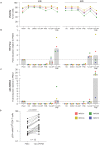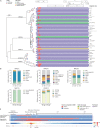Potent latency reversal by Tat RNA-containing nanoparticle enables multi-omic analysis of the HIV-1 reservoir
- PMID: 38110433
- PMCID: PMC10728105
- DOI: 10.1038/s41467-023-44020-5
Potent latency reversal by Tat RNA-containing nanoparticle enables multi-omic analysis of the HIV-1 reservoir
Abstract
The development of latency reversing agents that potently reactivate HIV without inducing global T cell activation would benefit the field of HIV reservoir research and could pave the way to a functional cure. Here, we explore the reactivation capacity of a lipid nanoparticle containing Tat mRNA (Tat-LNP) in CD4 T cells from people living with HIV undergoing antiretroviral therapy (ART). When combined with panobinostat, Tat-LNP induces latency reversal in a significantly higher proportion of latently infected cells compared to PMA/ionomycin (≈ 4-fold higher). We demonstrate that Tat-LNP does not alter the transcriptome of CD4 T cells, enabling the characterization of latently infected cells in their near-native state. Upon latency reversal, we identify transcriptomic differences between infected cells carrying an inducible provirus and non-infected cells (e.g. LINC02964, GZMA, CCL5). We confirm the transcriptomic differences at the protein level and provide evidence that the long non-coding RNA LINC02964 plays a role in active HIV infection. Furthermore, p24+ cells exhibit heightened PI3K/Akt signaling, along with downregulation of protein translation, suggesting that HIV-infected cells display distinct signatures facilitating their long-term persistence. Tat-LNP represents a valuable research tool for in vitro reservoir studies as it greatly facilitates the in-depth characterization of HIV reservoir cells' transcriptome and proteome profiles.
© 2023. The Author(s).
Conflict of interest statement
The authors M.P., B.C., L.L., W.V.S., S.R., Y.N., N.D.L., A.D. and L.V.D. declare no competing interests. The authors E.V.G., E.N., F.E. and D.B. declare the following competing interests: these authors are employees of Johnson & Johnson and may be Johnson & Johnson, stockholders. The author J.V. declares the following competing interests: this author was an employee of Arcturus Therapeutics and may be an Arcturus Therapeutics stockholder.
Figures








Similar articles
-
Nanoparticle delivery of Tat synergizes with classical latency reversal agents to express HIV antigen targets.Antimicrob Agents Chemother. 2024 Jul 9;68(7):e0020124. doi: 10.1128/aac.00201-24. Epub 2024 Jun 3. Antimicrob Agents Chemother. 2024. PMID: 38829049 Free PMC article.
-
Inhibition of ALKBH5 demethylase of m6A pathway potentiates HIV-1 reactivation from latency.Virol J. 2025 Apr 28;22(1):124. doi: 10.1186/s12985-025-02744-4. Virol J. 2025. PMID: 40296171 Free PMC article.
-
The role of Nef in the long-term persistence of the replication-competent HIV reservoir in South African women.J Virol. 2025 Jul 22;99(7):e0021725. doi: 10.1128/jvi.00217-25. Epub 2025 Jun 24. J Virol. 2025. PMID: 40552830 Free PMC article.
-
Applications and limitations of the passenger hypothesis for HIV reservoir persistence and cure.J Virol. 2025 Jul 22;99(7):e0071425. doi: 10.1128/jvi.00714-25. Epub 2025 Jun 4. J Virol. 2025. PMID: 40464563 Free PMC article. Review.
-
Structured treatment interruptions (STI) in chronic unsuppressed HIV infection in adults.Cochrane Database Syst Rev. 2006 Jul 19;2006(3):CD006148. doi: 10.1002/14651858.CD006148. Cochrane Database Syst Rev. 2006. PMID: 16856117 Free PMC article.
Cited by
-
HIV-1 Tat: Molecular Switch in Viral Persistence and Emerging Technologies for Functional Cure.Int J Mol Sci. 2025 Jun 30;26(13):6311. doi: 10.3390/ijms26136311. Int J Mol Sci. 2025. PMID: 40650088 Free PMC article. Review.
-
CD4 downregulation precedes Env expression and protects HIV-1-infected cells from ADCC mediated by non-neutralizing antibodies.mBio. 2024 Nov 13;15(11):e0182724. doi: 10.1128/mbio.01827-24. Epub 2024 Oct 7. mBio. 2024. PMID: 39373535 Free PMC article.
-
Synthesis and preclinical evaluation of tigilanol tiglate analogs as latency-reversing agents for the eradication of HIV.Sci Adv. 2025 Jan 24;11(4):eads1911. doi: 10.1126/sciadv.ads1911. Epub 2025 Jan 24. Sci Adv. 2025. PMID: 39854456 Free PMC article.
-
Cognate antigen engagement induces HIV-1 expression in latently infected CD4+ T cells from people on long-term antiretroviral therapy.Immunity. 2024 Dec 10;57(12):2928-2944.e6. doi: 10.1016/j.immuni.2024.11.002. Epub 2024 Nov 28. Immunity. 2024. PMID: 39612916
-
Advancements in single-cell techniques for examining the HIV reservoir: pathways to a cure.mBio. 2025 Jul 9;16(7):e0065525. doi: 10.1128/mbio.00655-25. Epub 2025 Jun 9. mBio. 2025. PMID: 40488537 Free PMC article. Review.
References
Publication types
MeSH terms
Substances
LinkOut - more resources
Full Text Sources
Molecular Biology Databases
Research Materials

